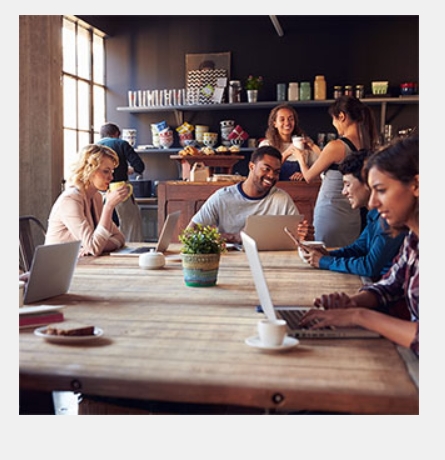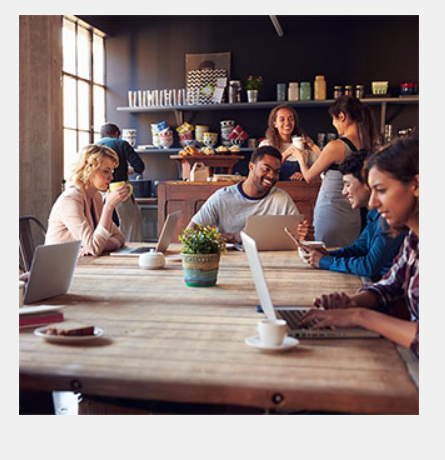
 Walk into any coffee shop during ‘office’ hours and try to find an open table. You will likely have to wait, unless you are very lucky. Coffee shops, swanky hotels, and other public places have become the favourite office of freelancers, gig workers, and side-hustlers.
Walk into any coffee shop during ‘office’ hours and try to find an open table. You will likely have to wait, unless you are very lucky. Coffee shops, swanky hotels, and other public places have become the favourite office of freelancers, gig workers, and side-hustlers.
This growing cohort of professionals has broken away from the codes and constraints of traditional corporate life. It is also now part of the gig economy, a way of working in which people have temporary jobs or do separate pieces of work rather than working for an employer.
Today, millions of people are either autonomously working for a salary or legitimately working as their own enterprise. Indeed, 94 percent of all net new jobs created over the past 10 years have been freelance or part-time. Overall, independent contractors now account for more than a third of the U.S workforce.
THE CHANGING DEFINITION OF WORK: FREELANCIA STANDS FOR FREEDOM AND FULFILLMENT
In a reflection on the future of work and society, The International Labor Organization underscored the changing values and definitions of work. Although most people work to live, it said, they are also driven by strong cultural and psychological norms and ultimately need to engage in meaningful life projects. Work can be a means of survival for some and a lifestyle choice for others. To that end, freelancers often tout their worklife balance, the freedom to choose the projects they work on, and the fulfillment derived from constantly learning new skills and meeting new people. Companies of all sizes hire freelancers for their skills, reputation, and (maybe most importantly) flexibility.
With flexibility comes precariousness. Freelancers are constantly on the hunt for their next project, spending time, money, and efforts marketing themselves without knowing for sure if and when they will secure their next gig. Also, platforms that facilitate the gig-economy such as Uber, Fiverr, and Upwork often charge steep commissions in return for the work they bring to their freelance members. Finally, there are many more freelancers available for hire than there are projects, which tends to drive market prices (and therefore freelancers’ income) down.
In sum, Freelancia does not necessarily lead to fame and fortune, but it does fulfill a central tenet of the American Dream: being your own boss.
FREELANCIA NEEDS TO BELONG
Working freelance can be lonely. Just like all of us, freelancers long for interaction with other humans and want to belong to a tribe of like-minded people.
Working from a coffee shop is not inexpensive, but it offers some scenery. Paying $300 a month to a shared workplace for a “hot desk” is about $299 more expensive than working from one’s kitchen table. WeWork and other shared workspaces offer way more than office space, free beer, and logistical support. They foster communities of entrepreneurs, creators, and venture capitalists. Each WeWork location also employs a community manager who sets up events such as book clubs, wine tastings, ping-pong tournaments, and mediation classes. There is even a WeWork bootcamp held every summer in the Adirondacks, to inspire ‘members’ (not tenants) and employees alike.
HOW BRANDS CAN HARNESS THE POWER OF FREELANCIA
Although self-employment used to be disreputable and brought to mind the cliché of people working in their pajamas, freelancers now present a real opportunity for brands to acquire new clients and recruit talent. Here are three recommendations for brands looking to harness the power of Freelancia:
Freelancia is a mindset, not a demographic. Brands that wish to target Freelancia must reach gig workers with messages that align with their mindset of freedom, and fulfillment. They must also create useful and inspirational content that supports their brand’s mission, along with carefully-targeted media placement.
Address Freelancia’s functional and emotional pain points. To attract Freelancia, brands should try to address the functional and emotional pain points. This might be done by:
Developing offerings that simplify Freelancia’s day-to-day life and align with independent, always-on-the-go lifestyles. Brands can do this by reflecting on offerings that are readily available to office workers (such as connectivity, shipping, and health and wellness) and adapting them for Freelancia.
Offering a feeling of community and belonging. Despite all the scalable technology and global collaboration, we all find comfort in proximity and human interactions. Enable Freelancia to meet the freelancer next door.
Attract talent. Cloud computing, video conferencing, and other advanced technologies enable seamless collaboration between freelancers and their clients, giving brands access to talent across the globe. Dabble into Freelancia by commissioning small projects first, such as a sales deck or a micro-site design. Get to know your freelancers over time and identify other areas in which they could support your organization. Remember that freelancers are talented and dependable individuals, regardless of what they wear to work.
The bottom line is that Freelancia is here as both a cultural and economic force. It’s attractive to the kinds of talented and motivated people who are increasingly scarce in the fulltime world. Brands that can find ways to nurture and collaborate with Freelancia will find a flexible workforce that’s ready to help in almost any way needed.
Written by Dr. Emmanuel Probst Vice President, Media & Content Kantar Insights
